SAP Fiori – a concept, design and technology
SAP Fiori is a set of responsive mobile applications created in accordance with the new SAP paradigm of creating user interfaces called SAP User Experience (SAP UX). SAP UX is based on 3 pillars: a concept, design and technology. From the concept perspective, SAP Fiori applications are:
- role-based,
- responsive,
- simple,
- coherent,
- nice.
From the design perspective, SAP Fiori applications are created in accordance with the philosophy of Design Thinking, in which visual design, interaction patterns, etc. play a special role. From the technology perspective, SAP Fiori ensures full separation of the visual layer from the logical layer of the application. The visual layer is created in HTML5, JavaScript and CSS using SAPUI5 libraries, and the logical layer is implemented in the form of the so-called OData services. Within each pillar, SAP has developed a series of strict rules, guidelines and patterns that entirely contribute to what SAP Fiori really is. And it is not just a user interface – it is supposed to be a kind of experience.
Application types
There are three types of SAP Fiori applications:
- Transactional,
- Fact-Sheets,
- Analytical.
SAP Fiori application types differ in both intended use and technical requirements.
Transactional applications as the name suggests, are generally used to perform transactions, i.e. certain operations that change the status of documents in the system, e.g. approval of purchasing documents as part of the approval strategy. However, this is not always the case. Some transactional applications are only used to display data in a simple, user-friendly manner. From a technical perspective, transactional applications can be run on the SAP ERP system operating on any database.
Fact sheets are used to display key information about objects when searching the system using full-text search, the so-called Enterprise Search. A fact-sheet also shows links to other documents, e.g. a fact-sheet of a purchase order may contain links to a quantity contract, purchase requisition, GR documents and invoices. From a technical perspective, fact-sheets can be run on the SAP ERP system operating solely on the SAP HANA database.
Analytical applications are used to perform analyses, and more specifically, to present calculated KPIs (Key Performance Indicators) and aggregated data from which such indicators are calculated. With the Drill-Down option, the aggregated data can be displayed as a graph, e.g. a bar chart or in the form of a table. From a technical perspective, analytical applications can be run on the SAP ERP system operating solely on the SAP HANA database. Analytical applications are based directly on the SAP HANA views and therefore require the SAP Web Dispatcher to be run.
Each application type requires additional components to be installed in the SAP ERP system, e.g. transactional applications require front-end components (these are SAPUI5 sources, e.g. JS files), back-end components (these are implementations of OData services). For ABAP servers older than 7.40, the SAP Gateway component (a framework in which OData services are implemented) must be installed. Analytical applications require the SAP Smart Business components to be additionally installed in the SAP ERP system, and additional components to be installed in the SAP HANA database itself, such as the SAP HANA Live view library. Therefore, the implementation of SAP Fiori on the SAP ERP system must be preceded by a thorough analysis performed by BASIS consultants, who will check which components should be installed. However, it is true that only those companies that migrated their SAP ERP system to the SAP HANA database can use the entire range of SAP Fiori capabilities.
SAP Fiori Launchpad
SAP Fiori Launchpad is a website launched in a web browser where the user gains access to the SAP Fiori application in the form of so-called tiles (Fig. 1). One tile corresponds exactly to one SAP Fiori application, and more specifically, to one task to be performed as part of one user role in the organization.
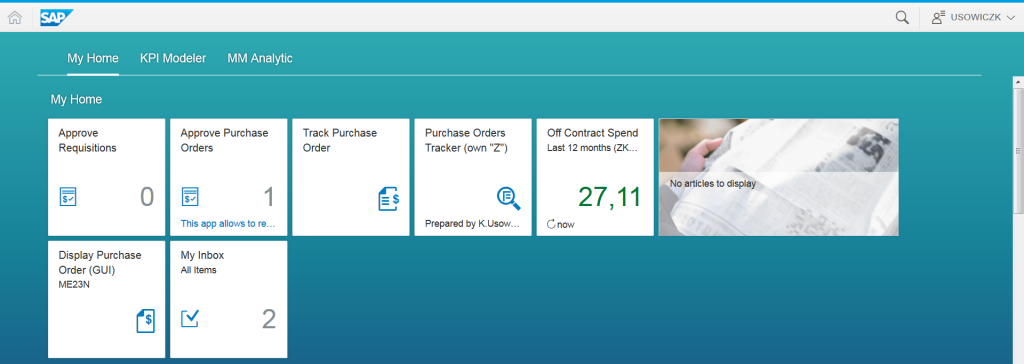
Fig. 1. SAP Fiori Launchpad
Tiles that the user sees on their start page result directly from the roles assigned to the user, so-called front-end roles. The front-end roles contain links to the relevant SAP Fiori application directories. Users can freely shape their start page, e.g. they can group tiles differently, they can hide unnecessary tiles, etc. Administrators can freely shape the directories available to users.
An important element of the SAP Fiori Launchpad start page is the full-text search field visible in the upper right corner (Fig. 2). In this field, you enter the text you are searching for, e.g. an SAP user name. Right next to it, you can choose a set of searched documents (e.g. purchase orders). It is also possible to search through without specifying the searched collection. Full-text search is enabled by the tools available at the SAP HANA database level.
Fig. 2. Full-text search field
Transactional applications
One of the first SAP Fiori transactional applications prepared by SAP in the MM module are applications used to accept purchasing documents. Very often, purchasing documents (for example, purchase orders with a value above some threshold, e.g. PLN 50,000) must be accepted by medium-level or even high-level management. SAP Fiori applications enable managers to approve such documents on their smartphones.
When using the SAP Fiori Launchpad, the application tile for approval indicates the number of documents waiting for approval (Fig. 3). By clicking the tile (or touching it with your finger on the touch screen), you start the main application view (Fig. 4). All SAP Fiori applications for approval of purchasing documents are built in accordance with the so-called “Master-Detail” design template. This template consists of two parts. In the left part, there is a list of documents to be processed. In the right part, there are details of the currently selected document. At the bottom of the application, there are buttons used to make a decision (Accept/Reject). “Out of the box” SAP Fiori applications contain only the most important information needed to make a decision, however they can be extended with additional standard or custom fields (there are appropriate extension places).
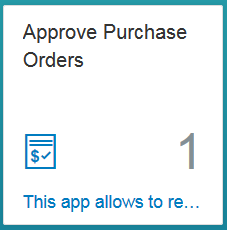
Fig. 3. SAP Fiori tile Approve Purchase Orders
For the SAP ERP system, there are dedicated SAP Fiori standard applications for approving:
- requisitions,
- purchase orders,
- contracts,
- service entry sheets,
- invoices.
SAP Fiori applications for approval of purchasing documents are closely integrated with the so-called approval strategy and require at least a standard workflow template to be activated in the MM module.
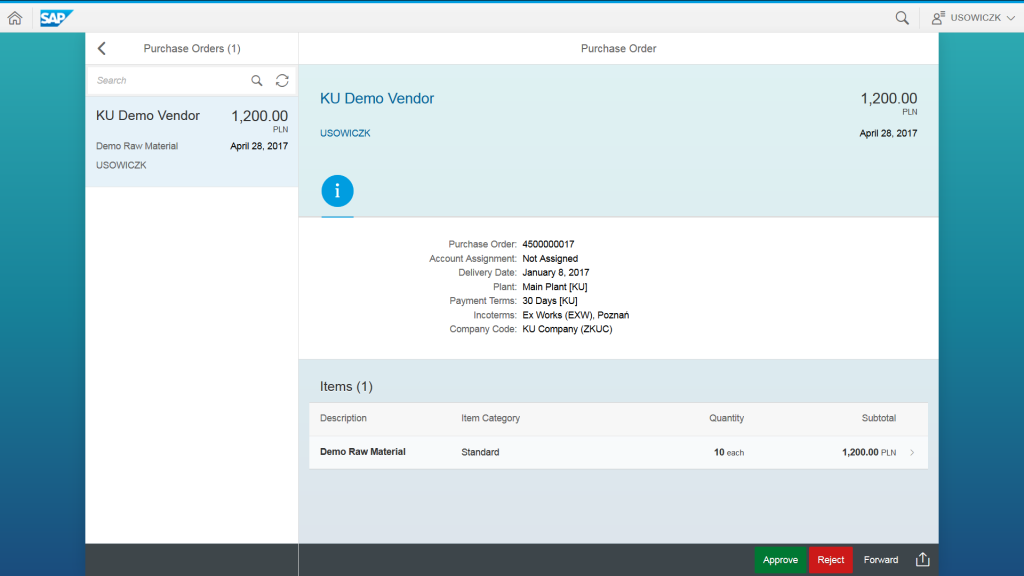
Fig. 4. Approve Purchase Orders SAP Fiori application
Another example of the SAP Fiori transactional application in MM is the Track Purchase Order application (Fig. 5). Similarly to applications for approval, the Track Purchase Order application is also built according to the “Master-Detail” design template. On the left side, there are purchase orders (it is possible to set up a suitable filter, e.g. the previous 90 days or the previous 90 days – only with an alert). On the right side, you can see the details of the purchase order history, e.g. quantities received and quantities invoiced. The functionality of filtering purchase orders with an alert is an interesting one. If the filter with an alert is used, the system will display only those purchase orders that require special attention of the buyer.
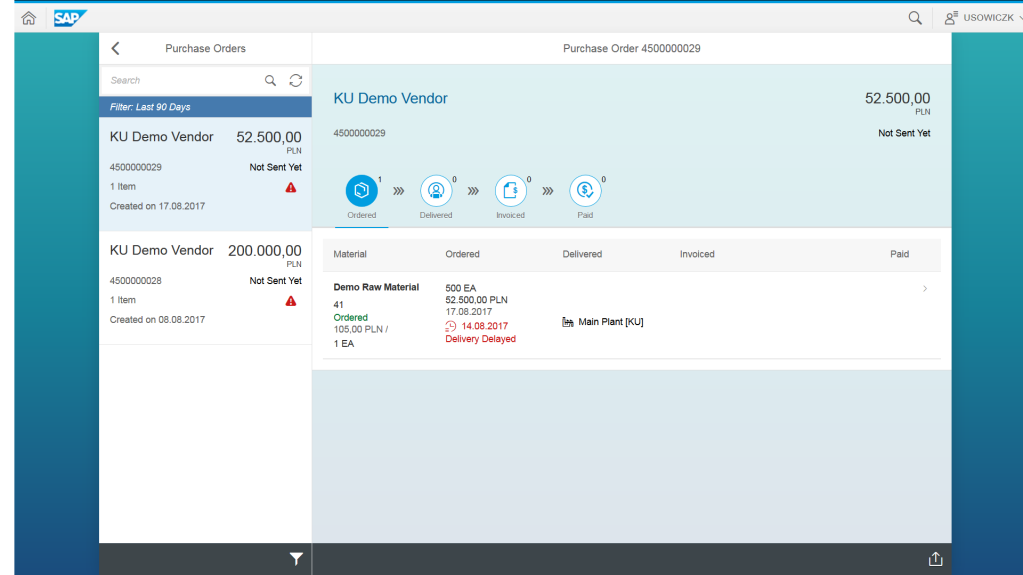
Fig. 5. Track Purchase Order SAP Fiori application
There are also other SAP Fiori transactional applications, such as:
- Order from Requisitions – creation of orders based on requisitions,
- My Purchasing Document Items – review of purchasing documents.
Fact-sheet applications
Fact-sheet applications are closely related to the full-text search available at the SAP Fiori Launchpad level. After completing the database search, a list of found documents, e.g. purchase orders, is presented to the user. A search string – if it is visible on the document preview screen – is highlighted in yellow (e.g. SAP user as in the example in Fig. 6). The SAP Fiori fact-sheet application can be called up by simply clicking on the link with a number and key description of the document.
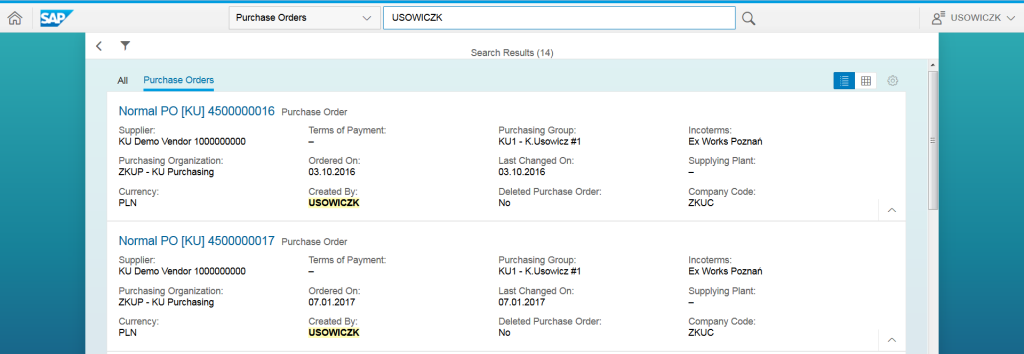
Fig. 6. Full-text search results
SAP Fiori fact-sheet applications have a very simple structure: they consist of several frames that present key information about the document, and related documents. For example, the application for purchase orders (Fig. 7) contains links to contracts, receipts, invoices, and requisitions. Each linked document is represented in the form of a link whose clicking takes the user to the proper fact-sheet application relevant for that document. Thus, the individual fact-sheets are closely linked with one another. The full-text search and fact-sheet applications enable users to easily search for and navigate through documents, quickly obtaining most of the key information (e.g. whether the receipt for a purchase order has been made already, whether any purchase orders have been sent already to the vendor or whether the requisition is processed into a purchase order, etc.).
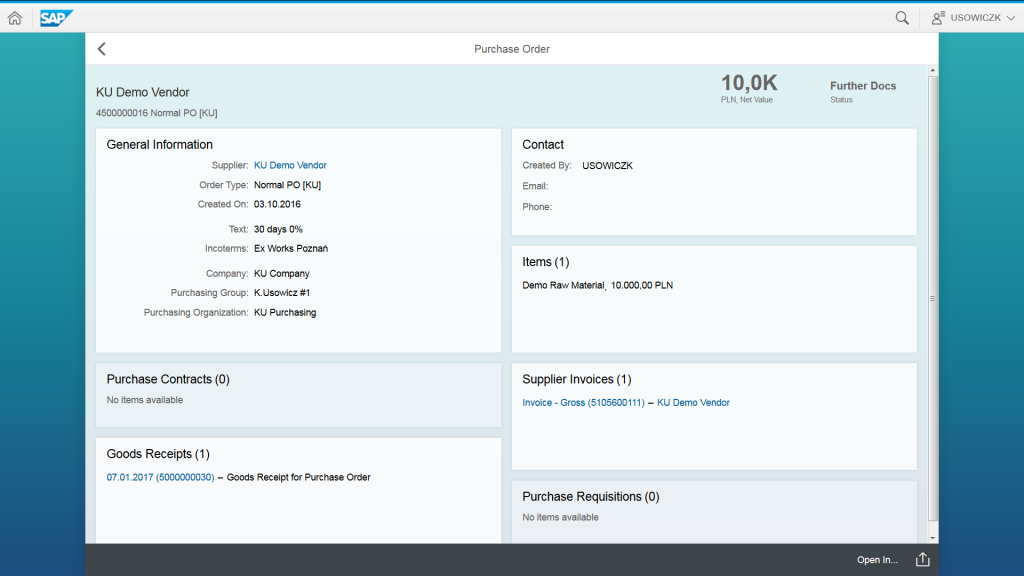
Fig. 7. SAP Fiori Fact Sheet application for a purchase order
Fact-sheet applications are available for most objects and documents in MM: materials, vendors, information records, requisitions, purchase orders, contracts, material documents, invoices.
Analytical applications
Analytical applications are directly based on SAP HANA views and can display calculated key performance indicators (KPI). The indicators are calculated live from transaction data. Thus, each posting of a single document has a direct and immediate impact on the value of the related indicator. This creates enormous, unprecedented possibilities to monitor the organization’s efficiency. As part of the SAP HANA Live view library, a number of views prepared for purposes of the MM module are available.
An example of an analytical application for, for example, merchants or purchasing managers is the Off-Contract Spend application. The view on which the application is running generates an indicator that specifies a percentage share of purchases without references to a contract. The example in Fig. 8 shows a tile with a KPI value = 27.11%. This means that slightly over ¼ of purchases is made without reference to a contract. Purchases based on a contract are generally more cost-effective than ad-hoc purchases, since a contract price (related, for example, to some contracted quantity) is usually lower. Thus, the lower the value of this indicator, the better. In the configuration of the analytical tile, it is specified whether the higher/lower value of the indicator is better.
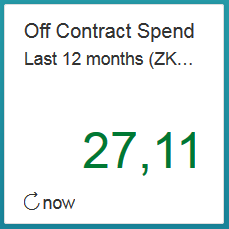
Fig. 8. SAP Fiori tile Off Contract Spend
It is also possible to indicate the value thresholds for which the indicator color is specified. For example, the green color may mean that the indicator is normal, and the red color may indicate a situation requiring immediate intervention.
If analytical applications showed only one value of the indicator, their use value would not be so impressive. However, analytical tiles can be clicked to display various graphs related to a given indicator (graphs are defined in the so-called KPI Framework). Figure 9 shows how the indicator for one vendor (KU Demo Vendor) changed throughout the year. It is visible that until July 2017 the indicator was 100% (therefore, no contracts with this vendor were used). It was not until August that purchases were made based on contracts, as the indicator fell to 20.79%. As the total indicator is 27.11%, this indicates a significant increase in the value of purchases in August 2017 from this vendor (in this example, the total indicator is also calculated for one vendor – in normal conditions, it would be calculated for all vendors).
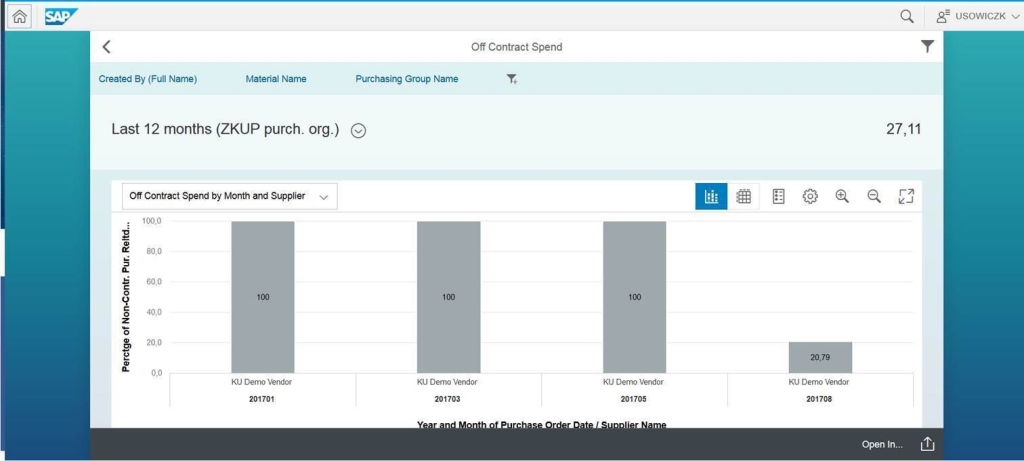
Fig. 9. Off-Contract Spend SAP Fiori application (bar chartview)
Various views are available to create applications (analytical tiles), such as: a value of stock priced for a specific date, a quantity of stock priced for a specific date, a scope of coverage based on historical consumptions, stock rotation, expected versus actual use of contracts.
Integration with workflow – My Inbox application
Regardless of the standard SAP Fiori applications for approval of purchasing documents described earlier, a generic workflow task inbox is also available – the SAP Fiori My Inbox application (Fig. 10). The application is generic, since it can operate with any workflow templates and has great configuration capabilities, e.g. it is possible to filter workflow tasks (then in My Inbox, not all workflow processes are visible, but only selected ones). You can implement your own logic for the Accept and Reject buttons, which enables you to use the application with completely non-standard acceptance processes. In addition, the application allows you to enter comments and attachments. In a word, the application provides everything that is needed for efficient decision making. The number on the application tile indicates the number of workflow work items awaiting a decision.
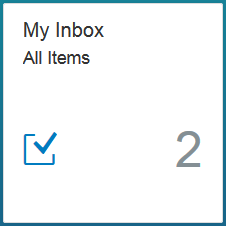
Fig. 10. SAP Fiori tile My Inbox
Fiori Apps Library
You can check the available SAP Fiori applications yourself by browsing the SAP Fiori library on the website https://fioriappslibrary.hana.ondemand.com/sap/fix/externalViewer/. In order to see applications that can be implemented on the SAP ERP system (not S/4HANA!), select the “Fiori apps for SAP Business Suite” filter (Fig. 11). Applications can be searched using filters by industry, roles, SAP application component (e.g. MM-PUR for purchasing in MM) or SAP ERP system version (by Back-End Product).

Fig. 11. Fiori Apps Library
Future of interfaces
SAP Fiori applications not only look nice, but can really improve the company’s operations. Transactional applications supporting the approval of purchasing documents can significantly streamline acceptance processes by redirecting an acceptance task to smartphones, which can be liked by the management staff. Fact-sheet applications in conjunction with full-text search capabilities based on the SAP HANA engine can help find necessary information in the system faster. Finally, analytical applications provide insights into how efficiently a company operates by calculating various key performance indicators (KPI).
SAP Fiori is the future of user interfaces of SAP systems – especially S/4HANA. However, you can use SAP Fiori now, even if you have an SAP ERP system, although it is recommended to transfer it first to the SAP HANA database.
